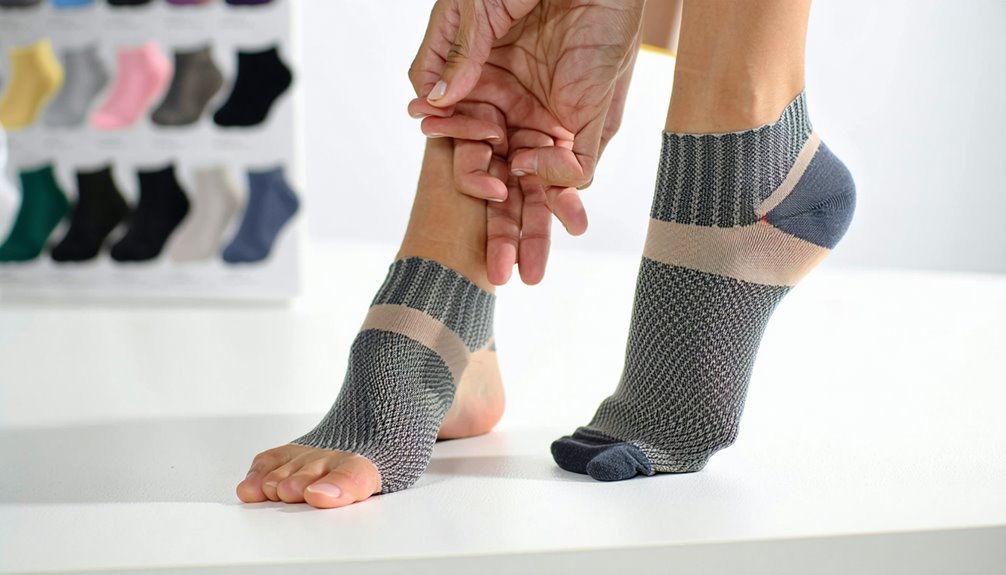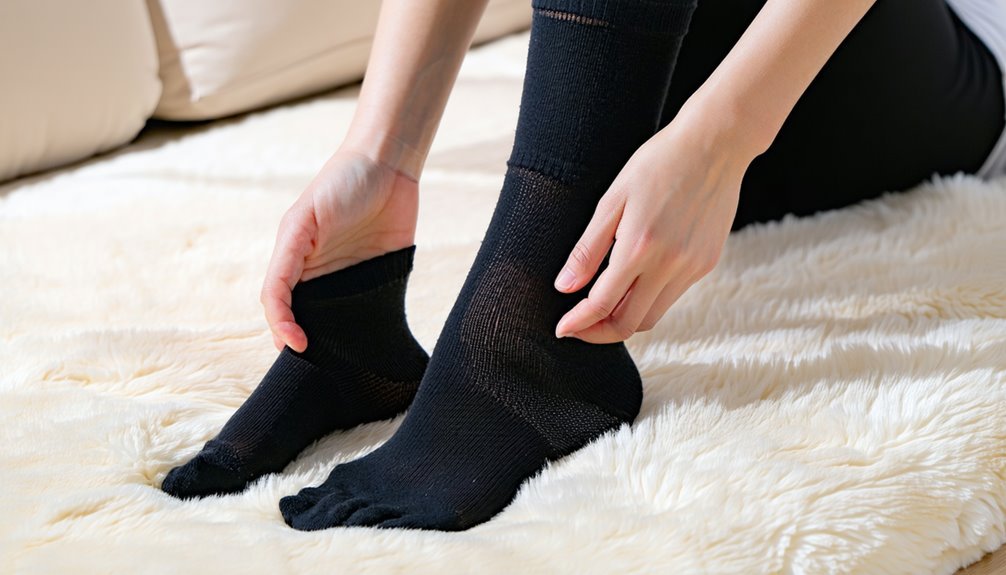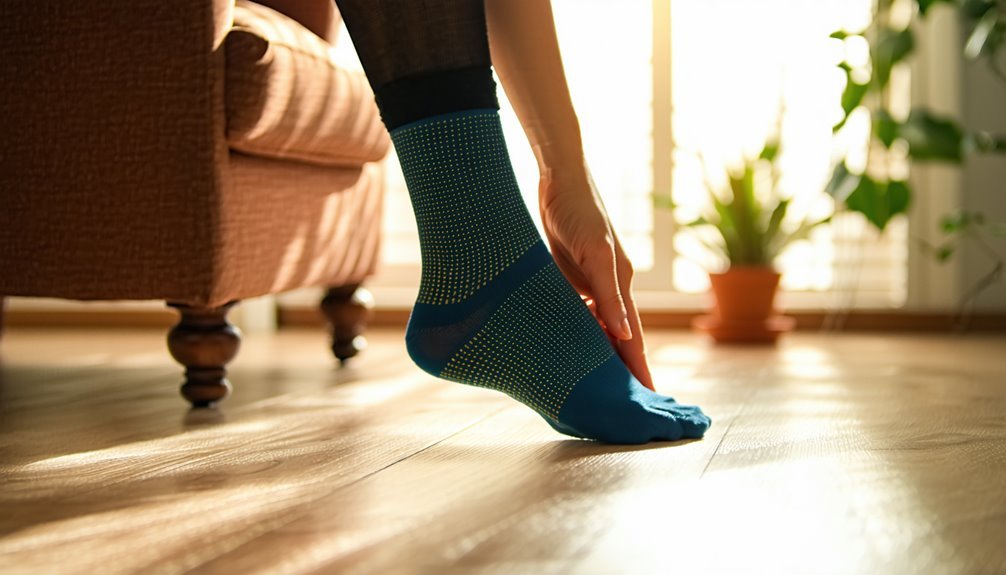How to Put on Compression Socks
To put on compression socks, first turn the sock inside out, leaving the toe section exposed. Slide your foot in and gradually pull it up your leg, smoothing out any wrinkles as you go. Make sure the sock fits snugly without causing discomfort. If you struggle to put them on, consider using a sock aid for assistance. By following these steps, you can enjoy better comfort and circulation, and there's more to learn about maintaining them effectively.
Choosing the Right Compression Socks

When you're looking for the right compression socks, how do you know which ones to choose? First, consider the compression levels. Socks come in varying levels, typically ranging from mild (8-15 mmHg) to high (30-40 mmHg), depending on your needs. If you're unsure, consult a healthcare professional to determine the best level for you. Next, pay attention to sock materials. Look for options that offer breathability and moisture-wicking properties, such as nylon or spandex blends. These materials not only provide comfort but also help prevent irritation during prolonged wear. Finally, verify the fit is snug but not overly tight—proper sizing is vital for effectiveness. Choosing the right socks can greatly enhance your comfort and safety throughout the day.
Preparing Your Legs
Before you slip on your compression socks, it's essential to prepare your legs properly. Taking a few moments for this step can enhance your leg health and maximize circulation benefits. Here are three simple steps to get your legs ready:
- Clean and Dry: Make certain your legs are clean and completely dry. Moisture can affect the fit and effectiveness of the socks.
- Check for Skin Conditions: Inspect your skin for any irritations, rashes, or injuries. You want to verify your skin is healthy before wearing compression gear.
- Elevate Your Legs: If you've been standing or sitting for long periods, elevate your legs for a few minutes. This helps improve circulation and prepares your legs for the socks.
Putting on Compression Socks
Pull on your compression socks with care to guarantee they fit snugly and provide the intended support. Start by turning the sock inside out, leaving just the toe section showing. This technique for application makes it easier to slide the sock onto your foot. Place your foot inside and gradually pull the sock up your leg, smoothing out any wrinkles as you go. Confirm the sock is snug but not overly tight; you should feel the benefits of compression without discomfort. If you're struggling, consider using a sock aid for assistance. Properly applied compression socks help improve circulation, reduce swelling, and alleviate fatigue, making them a valuable addition to your daily routine.
Adjusting for Comfort

Although compression socks are designed for support, it's important to adjust them for maximum comfort. Properly adjusting fit can help guarantee circulation and prevent discomfort during wear. Here are a few tips to achieve that:
- Check the Size: Make sure you've chosen the correct size based on your measurements. A snug fit is essential, but it shouldn't feel overly tight.
- Position the Socks: Guarantee the socks are pulled up evenly, with no bunching. This helps distribute pressure evenly across your legs.
- Monitor for Discomfort: Pay attention to any pinching or tightness. If you feel any discomfort, adjust the fit accordingly, repositioning the sock to maintain comfort while guaranteeing circulation.
Caring for Your Compression Socks
Caring for your compression socks is essential to guarantee they remain effective and last longer. Start by washing them regularly using gentle cleaning methods. Hand-washing in cold water with mild detergent is best, but if you use a washing machine, choose a delicate cycle. Avoid fabric softeners and bleach, as they can damage the material. After washing, let your socks air dry instead of using a dryer, which can weaken the elastic fibers.
For storage tips, keep your compression socks in a cool, dry place, away from direct sunlight. Folding them neatly helps maintain their shape. By following these steps, you'll make certain your compression socks continue to provide the support you need while extending their lifespan.
Frequently Asked Questions
Can I Wear Compression Socks While Sleeping?
You can wear compression socks while sleeping, but it's crucial to prioritize sock comfort. They may offer sleep benefits like improved circulation, but consult your doctor to verify it's safe for your specific health needs.
How Long Should I Wear Compression Socks Daily?
You should aim for a compression sock duration of 8 to 12 hours daily, following the daily wear guidelines. This helps improve circulation and reduces swelling, ensuring your legs feel comfortable and supported throughout the day.
Are There Any Side Effects of Wearing Compression Socks?
While compression socks can feel like a gentle hug for your legs, some people might experience side effects like skin irritation or discomfort. It's important to monitor how you feel while wearing them for safety.
Can Compression Socks Help With Swelling During Pregnancy?
Yes, compression socks can provide swelling relief during pregnancy. They improve circulation, reducing discomfort and offering pregnancy benefits. Always consult your healthcare provider to guarantee they're safe and suitable for your specific situation.
What Should I Do if My Compression Socks Feel Too Tight?
If your compression socks feel like a vice, it's time to reassess. Check the sizing guide to guarantee you're using the right compression levels. You shouldn't feel pain; comfort is key for effective support.







